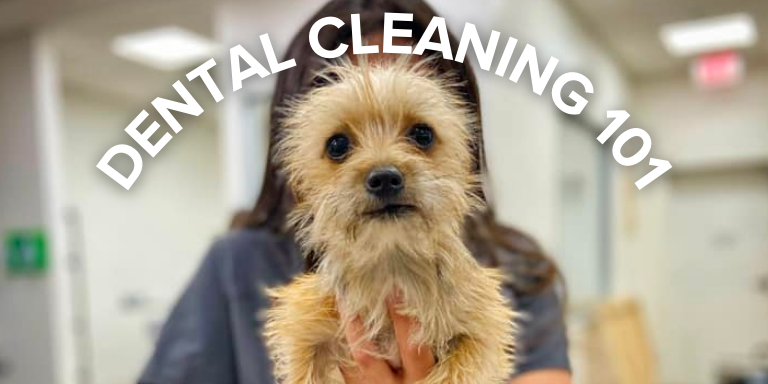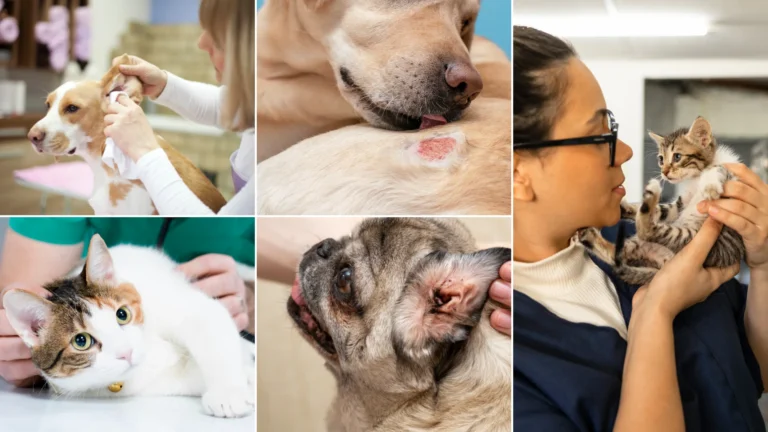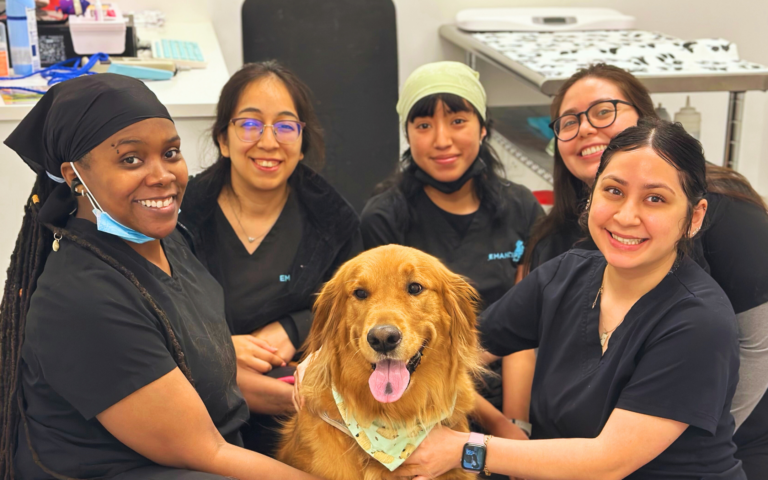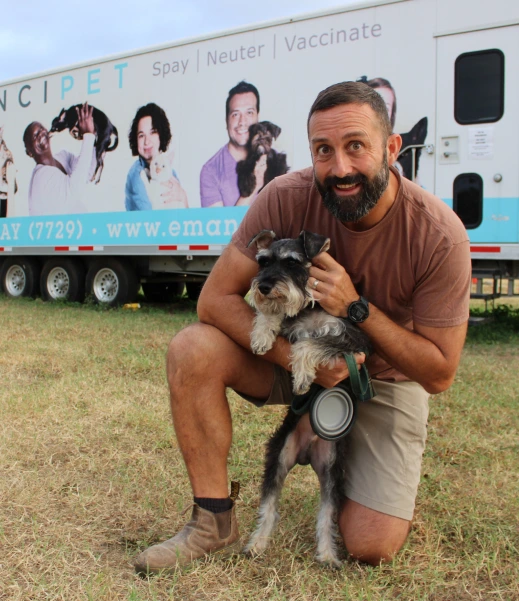Almost all dog owners have had our vets tell us that our dogs could benefit from a dental cleaning. Often neglected, dental cleaning is an important part of a dog’s health that should not be overlooked. As a basic rule of thumb, your furry friend(s) should get their teeth cleaned by a licensed veterinary dentist at least once a year. This article will break down how often your pet needs a dog dental cleaning, why, and what happens during the process.
How Often Does My Dog Need a Dental Cleaning?

Most veterinary dentists recommend that dogs should have their teeth cleaned once a year. However, this can largely depend on the breed and if the dog has any pre-existing health conditions. Larger dogs tend to need one dental cleaning per year, or in some cases, less often. Smaller dogs sometimes need two visits a year to prevent teeth loss. Because of high demand for reduced-cost dental services, at Emancipet we focus our efforts on dogs with moderate to severe dental disease.
At Emancipet, a dental evaluation can be done as a part of your pet’s regular wellness visit. Just ask the technician at check-in for a dental exam and the doctor will look at your dog or cat’s teeth and let you know whether a cleaning or extractions may be needed. Please note that dentistry is not available at all Emancipet clinics- feel free to ask at check-in or call our Resource Center for information about services offered in your area.
If your pet exhibits the following signs, you should consider getting their teeth cleaned immediately. Discolored or broken teeth, excessive bad breath, reduced appetite, and bloody drool indicate that your dog needs immediate dental health. Don’t hesitate to contact a veterinarian about your dog’s teeth, even if you aren’t sure something is wrong.
If you’re curious about your pet’s individual dental needs, it’s a good idea to take your pet in for a dog dental check up. This doesn’t have to be done as part of a special appointment. Most vets are more than happy to take a quick look at your dog’s teeth and tell you if/when they should come in for a cleaning when asked. However, it is likely that a separate appointment will be necessary for the actual cleaning.
Do Dogs Really Need to Have Their Teeth Professionally Cleaned?
Medical procedures for dogs can be very expensive. Especially for those without pet insurance. You may have found that cleaning your dog’s teeth can be too expensive and instead decided to use an at-home option like toothbrushes and dental dog treats. While these options can be great at preventing excessive dental disease or prolonging the time between dental cleanings, for dogs that already have moderate-severe oral disease this is not a sufficient replacement.
Failing to have your dog’s teeth cleaned by a professional can open up your pet to many health issues. Periodontal, or tooth disease, can affect up to one in three dogs before they reach the age of three. Dental disease can wreak havoc on your dog’s body in the form of tooth root abscesses, oral pain, or even blood infections that can spread to other parts of their body like the heart or liver. As with any other aspect of your dog’s health, it is crucial to have a trusted professional regularly clean your dog’s teeth, and to maintain dental health between visits with regular tooth brushing and/or VOHC (Veterinary Oral Health Council)- approved dental treats.

How Old Should Dogs be For Their First Teeth Cleaning?

It is generally accepted that dogs need to have their first teeth cleaned at around 2-3 years of age. Again, this can depend on the breed. Small dogs may need to have their first dental cleaning as early as two years of age. Waiting longer than this can expose your dog to problems like periodontal disease, and may also increase the need for tooth extractions.
At Emancipet, due to the high demand for our services, our dental services focus mostly on older dogs who already have dental disease.
Even if your young dog shows no obvious signs of oral pain or problems, this does not exempt them from needing teeth cleaning. Veterinary dentists love to say that the issues you can’t see with your naked eye in your dog’s mouth are the ones that could really hurt your pet.
How Does the Teeth Cleaning Process Work for Dogs?
Unlike humans, veterinary dentists don’t ask your dog to say “Ahh.” Veterinary dentistry is actually a complicated procedure that often involves x-rays and anesthesia. Because of this, it is important to take your dog to a licensed veterinarian for dental cleanings.
All dogs are unique, so no two dental cleanings will be exactly alike. However, a dog dental cleaning usually follows a similar process.
Veterinary dental care cannot be safely and successfully carried out unless anesthesia is used. X-Rays and cleaning under the gums cannot be done in an awake animal, which is why anesthesia is necessary. Also, x-rays help reveal if any teeth need to be removed. Some places will play into the client’s fear of anesthesia and claim to offer dog dental checkups and cleanings without anesthesia. However, such procedures often only clean off any visible grime from your pet’s mouth. This does very little for your dog’s dental health beyond what you could have accomplished with a toothbrush at home.
Before your dog is put under anesthesia, the vet will likely run blood tests to ensure that anesthetic drugs are safe to use on your pet. After your dog has been put under, cleaning your dog’s teeth is actually relatively similar to how your own teeth get cleaned when you visit the dentist. A variety of instruments are used to identify and remove all plaque and tartar from your dog’s mouth. Then, your dog’s teeth are usually polished.

After plaque removal and polishing, dental x-rays are usually taken. An x-ray technician will take oral x-rays of your dog to identify any issues that may not be readily visible in your dog’s mouth. This is a very important step in the teeth cleaning process. With dogs, many of the dangerous problems associated with poor oral health happen below the gum line, inside your dog’s teeth and gums.
What is the Recovery Involved After My Dog’s Dental Cleaning?

Because your dog was put under anesthesia, it will need to recover at the vet’s office for a few hours. The vet will monitor your pet and make sure that no complications have arisen from their procedure. Once your dog can walk on its own, the vet will usually call you and tell you that it is time to come pick up your pet!
Once home, you shouldn’t see any major side effects other than your pet being sleepy for a few hours. It is normal for dogs to feel stressed after a dental cleaning because they were put under anesthesia and are unsure of what happened.
If your dog had teeth extracted, they may be sent home with additional pain medication and instructions to eat soft food for a period of time while their mouth heals. Please ask your veterinarian if you have any questions about your pet’s specific recovery plan.
Your dog should have a normal appetite and return to its normal self a few hours after the procedure. However, if anything seems off, don’t hesitate to call your vet and ask for advice.
Ask A Vet: What About Brushing Between Cleanings?
After a professional dental cleaning, brushing your pet’s teeth at home can help keep tartar and bad breath at bay until their next procedure. Dr. Mulé offers some tips in this video.
The most important tip? Use pet formulated toothpaste, not human toothpaste.
Toothpaste for humans can have xylitol and fluoride which can be toxic to pets.
Conclusion
Dog’s dental health is just as important as any other aspect of their wellbeing. Depending on your pet’s size, you should have your dog’s teeth cleaned by a licensed professional around once a year. Dogs usually need to start receiving regular cleanings around two years of age. At your pet’s dog teeth check up, the vet will put your pup under anesthesia, clean and polish their teeth, and then take x-rays if deemed necessary. After a short recovery, your pet should have a clean bill of oral health.
Before you go – If you enjoyed this post, you probably love pets as much as we do! Did you know that you can sponsor a pet in need each month with a Nose to Tail Team donation and receive a limited-edition tote bag? Join our Nose to Tail Team and help a pet family get the care they need each month for just $0.54 a day.






